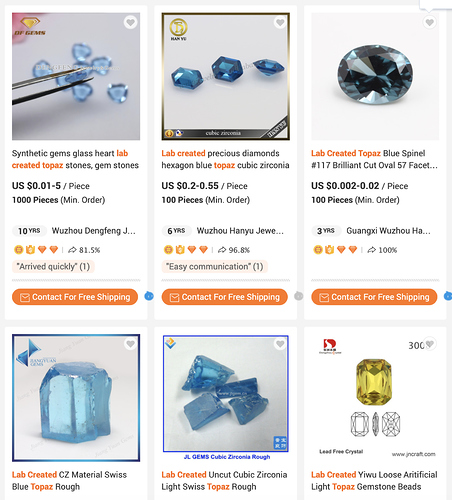Can you tell the difference between natural and lab created brownish topaz ?
The original post should have read " How can you tell the difference between natural and lab created brownish topaz? "
Thanks,
Wendell
Lab created topaz does not exist
I in no way mean to seem argumentative, but I have seen some websites for lab-created gemstones
including Topaz ( ie. Brilliant Cut Lab Created Topaz for Jewelry - Alibaba.com ).
Here is a couple of sentences from their website, " A wide variety of lab created topaz options are available to you, such as pear cut, round brilliant cut, and oval cut. You can also choose from mineral gemstones, synthetic (lab created). As well as from heat, radiation, and waxing/oiling. And whether lab created topaz is zircon, quartz, or sapphire."
" There are 1,718 lab created topaz suppliers, mainly located in Asia. The top supplying countries or regions are China, India, and Thailand, which supply 94%, 3%, and 1% of lab created topaz respectively. "
My main concern is being able to identify the Topaz I’m buying correctly, between lab or natural stones.
I do not mind lab created stones, as long as they are priced and sold as such. That way I do not misrepresent anything I may sell in the future.
L.W.McQueary
Glass, CZ, Cubic Zirconia, Blue spinel, these are misrepresented as “Lab Created Topaz” - The proper term would be “Simulated Topaz” as there are no synthetic topaz madder anywhere in the world.
I have to disagree with you! Artificially grown, synthetic topazes + dyed - exist and are successfully grown, but more for research purposes.
It’s just that it is not commercially profitable to grow in large volumes, but this does not mean that there are no synthetically grown topazes)
Regarding treated-color natural topaz, reddish brown is produced by ionizing irradiation, and blue is produced by high-energy electron irradiation with subsequent heat treatment, not dying. Mystic topaz is produced by a chemical vapour deposition (CVD) coating on natural topaz, not dying. There is no way to dye a topaz unless it is badly fractured, and it would be very easy to detect with the naked eye. In the early 2000’s, research scientists succeeded in synthesising light gray to colorless topaz crystals as overgrowths on natural topaz by hydrothermal crystal formation (Renfro, N. et al. G&G LXVI 2010 pg. 271). However, there is zero commercial demand for such a product, therefore, my statement “there are no synthetic topaz made anywhere in the world” is correct. No one is producing lab grown topaz. All claimed “Lab grown” or “synthetic” topaz on the market (eBay, Etsy, Alibaba etc.) are imitations, not topaz.
no, produced) and quite a long time ago and successfully. Because every day it becomes more and more cheaper than coloring natural raw materials in various ways.
The future is synthetic, unfortunately
While there are lab created Topaz Simulants there are no lab created Topaz gems. As seen in photos above there are various topaz simulants that are indeed created in a lab, Synthetic Spinel for instance or natural simulants, but, as Jbergman mentions above there are only insignificant by products of tiny crystals, they do not count for the purposes of this discussion as the conversation is of facetable size and quality gems. A synthetic is a version of a natural gem with the same properties while a simulant is merely a gem that looks the same and could be just man made glass.
Thanks,
DBH GIA GG, AJP
I would have to agree with @jbergman on this because the synthetics of topaz in the normal does not exist. The person asking this question probably meant that he wants to know the difference but for buying/selling purposes and not industrial purposes. The reason is that there is no incentive for producing lab created topaz. I did come across an article by Jeffery Bergman about radiated imperial topaz some years back, he can probably elaborate more about that if needed.
Also I you want to see topaz color chart, its here.
Hope it helps,
Regards
Navneet
B/c the process by which we make brown topaz from colorless natural topaz is pretty much the same as the way it would be done in the earth, there isn’t a method for telling if the topaz was originally brownish or if it was a clear topaz that was irradiated by humans. Either way, it wouldn’t be a synthetically produced topaz (no market for them, even mainstream jewelry stores cheaply sell irradiated clear natural topaz, usually irradiated to blue) but I doubt it would be more valuable if it were naturally that color than if it were irradiated to be that color. So, if it’s a matter of buying/selling the topaz, anyone buying brown/blue topaz should assume unless otherwise indicated that it’s been irradiated because the process is so commonplace. You can look into the IGS article on Topaz pricing for more info → Topaz Buying Guide - International Gem Society - IGS
